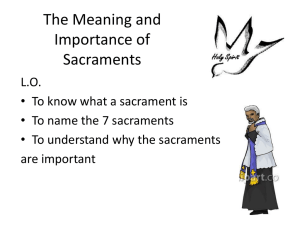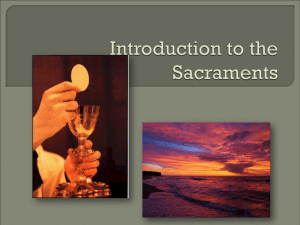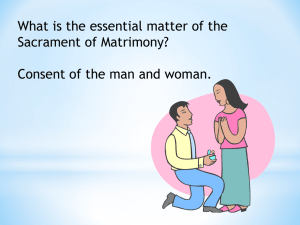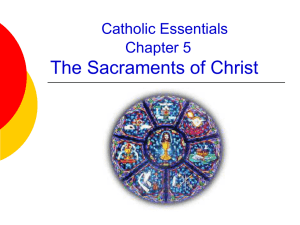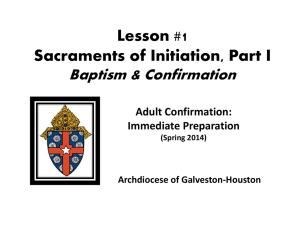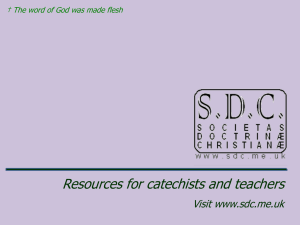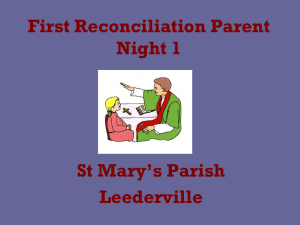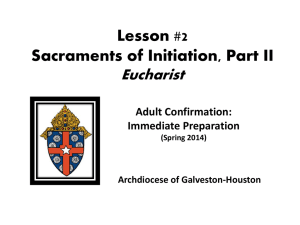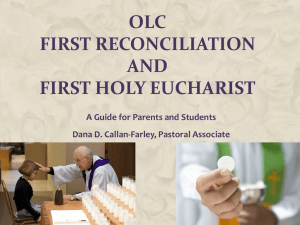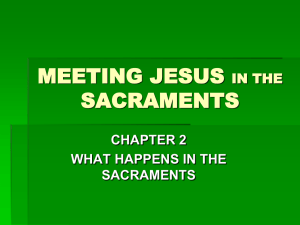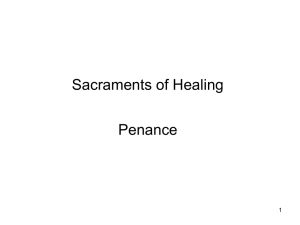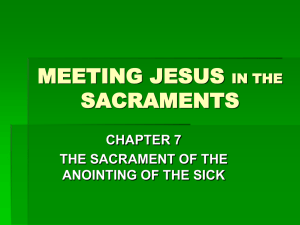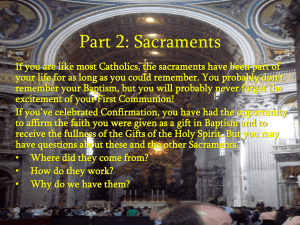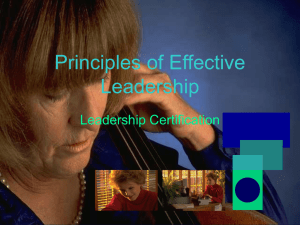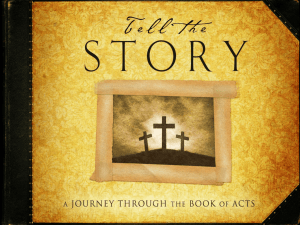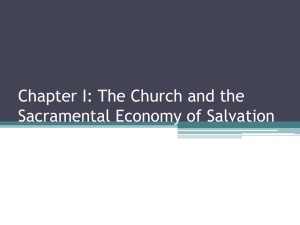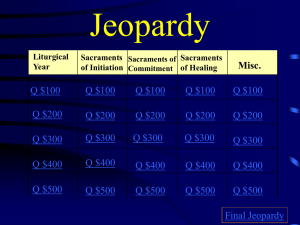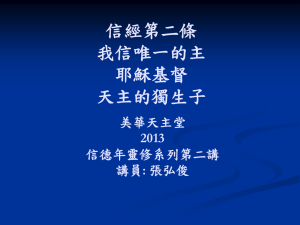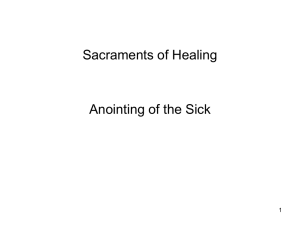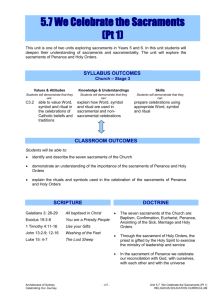The Sacraments of Initiation - St. Monica Catholic High School
advertisement
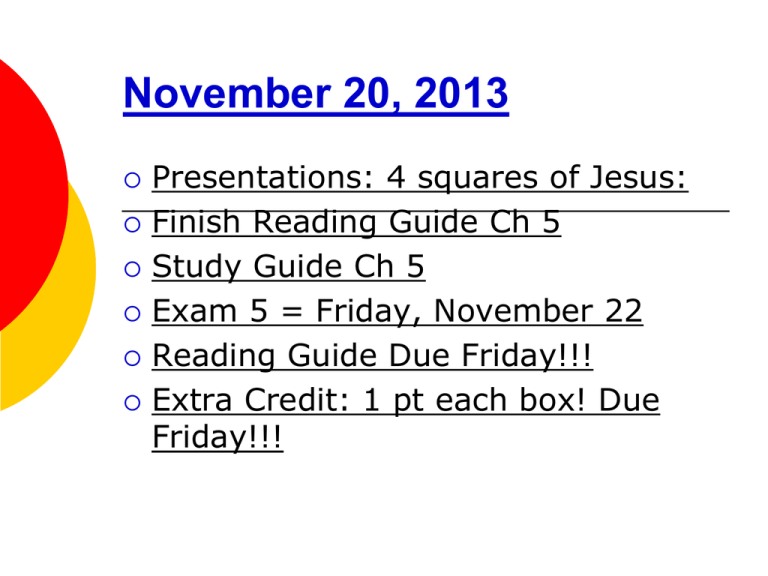
November 20, 2013 Presentations: 4 squares of Jesus: Finish Reading Guide Ch 5 Study Guide Ch 5 Exam 5 = Friday, November 22 Reading Guide Due Friday!!! Extra Credit: 1 pt each box! Due Friday!!! 7 Sacraments Baptism For Catholics, the Sacrament of Baptism is the first step in a lifelong journey of commitment and discipleship. Whether we are baptized as infants or adults, Baptism is the Church's way of celebrating and enacting the embrace of God. Eucharist Catholics believe the Eucharist, or Communion, is both a sacrifice and a meal. We believe in the real presence of Jesus, who died for our sins. As we receive Christ's Body and Blood, we also are nourished spiritually and brought closer to God. Anointing of the Sick The Catholic Sacrament of Anointing of the Sick, formerly known as Last Rites or Extreme Unction, is a ritual of healing appropriate not only for physical but also for mental and spiritual sickness. 7 Sacraments Reconciliation The Catholic Sacrament of Reconciliation (also known as Penance, or Penance and Reconciliation) has three elements: conversion, confession and celebration. In it we find God's unconditional forgiveness; as a result we are called to forgive others. Confirmation Confirmation is a Catholic Sacrament of mature Christian commitment and a deepening of baptismal gifts. It is one of the three Sacraments of Initiation for Catholics. It is most often associated with the gifts of the Holy Spirit. Marriage For Catholics, the Sacrament of Marriage, or Holy Matrimony, is a public sign that one gives oneself totally to this other person. It is also a public statement about God: the loving union of husband and wife speaks of family values and also God's values. Holy Orders In the Sacrament of Holy Orders, or Ordination, the priest being ordained vows to lead other Catholics by bringing them the sacraments (especially the Eucharist), by proclaiming the Gospel, and by providing other means to holiness. Catholic Essentials Chapter 5 The Sacraments of Christ Sacraments ARE what they symbolize To be a sacrament, a sign or symbol must do the following: Lead us to God Come from God Be an action of God The best example of a sacrament is Jesus Christ himself. Liturgy (the Work of the People) The first and most important work of the Church is to make present Christ’s Paschal Mystery here and now. We do this in liturgy. All the sacraments are liturgy – the work of the people…none are private affairs. Every sacrament is a community affair – an affair of the Church. Jesus is really present in Eucharist Jesus is present in the priest, the minister of the sacrament. Jesus is present when the Holy Scriptures are read. Jesus is present in the community assembled Jesus is really present in the consecrated species of bread and wine. The Seven Sacraments The Sacraments of Initiation – Baptism, Confirmation, Eucharist. The Sacraments of Healing – Reconciliation (Penance), Anointing of the Sick. The Sacraments at the Service of Communion – Matrimony, Holy Orders. Sacraments of Initiation Baptism – brings new life in Christ. Confirmation – strengthens our new life with the gifts of the Holy Spirit. Eucharist – nourishes us with the Body and Blood of Christ. “Cradle Catholics” Most Catholics are initiated into the Church as infants through the Rite of Baptism of Children. The child’s parents and godparents speak in the name of the child. Catechesis takes place after baptism. Formation is gradual as the child grows The other sacraments of initiation are received at a later time. Effects of Baptism Washes away original sin and any other sins and the punishment due. Makes us children of God and temples of the Holy Spirit. Welcomes us as members of the Church, the Body of Christ. Marks us forever as sharers in the common priesthood of all believers, and in Christ’s mission of justice and peace. Requirements for Reception of the Sacrament of Confirmation Be prepared to profess the faith. Be in the state of grace. Intend to receive the sacrament. Be prepared to witness to Jesus Christ. The Essential Rite of Confirmation Proper matter: Chrism Correct words or form: Laying on of hands and anointing with chrism on the forehead with the words: "(Name), be sealed with the gift of the Holy Spirit." Designated minister: Bishop Development of the Eucharist Christ instituted the Eucharist during a Passover meal held at the Last Supper as a memorial of his Death and Resurrection. At the Council of Trent (1545 – 1563) the doctrine of transubstantiation was defined and the Roman Missal was published by Pope Pius V. The Essential Rite of Eucharist Proper matter: unleavened bread and wine Correct words or form: Changing bread and wine into the Body and Blood of Christ by the words: "Take this, all of you, and eat it: this is my body which will be given up for you . . . Take this, all of you, and drink from it: this is the cup of my blood of the new and everlasting covenant. It will be shed for you and for all so that sins may be forgiven. Do this in memory of me.“ Designated minister: Bishop or priest Sacraments of Healing Anointing of the Sick Penance / Reconciliation Our new life in Christ can be weakened by suffering, illness, death, and the effects of sin. Penance – Reconciliation - Confession Penance renews, restores, and strengthens our relationship with God and the community after it has been damaged by sin. Penance shows that God’s love is without limits Healing and Forgiveness Essential Elements of Penance The acts of the person who undergoes conversion The intervention of the Church Contrition Confession Satisfaction Absolution from the priest All Catholics are required to go to confession at least once per year to confess serious sins God Alone Forgives Sin Christian life is marked by lifelong conversion Even though forgiveness is expressed through the Church and this Sacrament, God alone forgives sin Anointing of the Sick The sacrament encourages those who are sick to overcome the alienation caused by illness Jesus continues to bring healing through the prayers of the Church, and through the sacraments, especially the Eucharist and the Anointing of the Sick History of Anointing of the Sick In the Middle Ages the sacrament was administered only to the dying and was called Extreme Unction – “the Last Anointing.” Viaticum – is the final reception of the Eucharist. Since Vatican II, this sacrament is celebrated for those suffering from serious illness, for the elderly, for those facing major surgery -- and for the dying. Essential Elements of Anointing of the Sick The priest or bishop • lays his hands on the sick person prays for the person in the faith of the Church anoints the forehead and hands of the sick person with oil previously blessed by a bishop Sacraments at the Service of Communion These sacraments are directed toward the salvation of others, not toward those receiving the sacraments. Matrimony Holy Orders Holy Orders The ministerial priesthood Sacramental ordination consecrates certain baptized men to one of three degrees of a sacred order: Episcopate – bishops Presbyterate – priests Diaconate – deacons Essential Rite of Holy Orders A call by God to serve the Church in a very special way. Essential rite includes: the laying on of hands by the bishop accompanied by a special prayer of consecration. An indelible spiritual character is conferred on the ordained man. Matrimony Marriage is a sacred covenant -that is an agreement between the husband and wife, and between the couple and God. Matrimony From the time of creation, marriage has been an institution established by God, not by man. Sacramental marriage was modeled on the relationship between Christ and the Church The goodness of Marriage includes: The procreation of children. The chastity of the spouses and their fidelity to each other. The indissoluble union of marriage. The Essential Rite of Matrimony The essential element of Matrimony is the mutual consent to marry. The words of consent must be freely given. Catholics must marry in the presence of a priest or a deacon, and in the presence of two witnesses. The spouses themselves are the ministers of the sacrament. Matrimony The family is called “the domestic Church.” The family is a living witness and testimony of eternal, unbreakable, and boundless love that the couple (and their children) give to one another and to the world. The Seven Sacraments The sacraments celebrate Jesus as the Way, the Truth, and the Life. The sacraments are a way for us to live life to the fullest. The sacraments are the way to allow Jesus to touch our lives.
